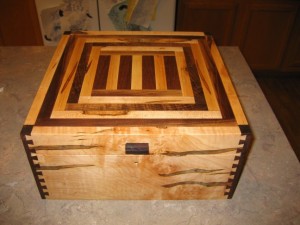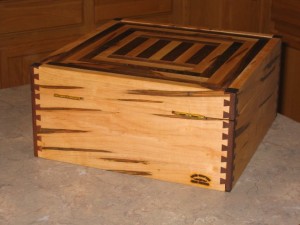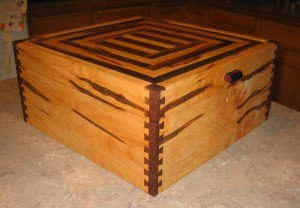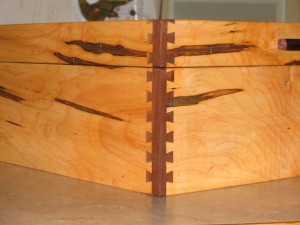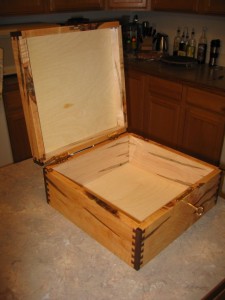Here is the original question thread posted over at Lumberjocks.com
how do you glue / epoxy knife scales on ? Mine fell off
coloradoclimber asked the question:
I bought some fixed blade knife kits from Woodcraft to make for Christmas. The “kit” is really just the blade, I have to add the scales and rivets.
I cut the wood for the scales, sanded the inside, sanded the blade tang, cleaned both the scale and the tang with acetone, mixed some two part epoxy, spread a thin uniform coat, then clamped for 24 hours.
I got the scales thinned to the thickness I wanted and was starting to shape them when the first scale popped off. I checked the other side and sure enough I could see the other scale was coming loose too, a quick poke with a pocket knife under the scale and it popped off too. I checked the others and I could see that at least 3 more were starting to pull loose. I tested them with a pocket knife and they popped off with a little prying. They probably would have held in place for a while but likely would have come off eventually.
So, now what? I’ve already shaped the scales and I would like to use them. I can epoxy them back on but I’m not sure what went wrong the first time. I made 4 knives, the first has wenge scales and those seem to be staying on. Two have cocobolo and 3 of those 4 scales are off. The last was chakte viga, that’s the one that popped both scales off first.
I thought maybe it was the wood, that the epoxy was not sticking to the wood because of some oils or something but when the scales popped off all of the epoxy was attached to the scale and almost none on the tang.
Next I’m thinking maybe it is because of moisture content in the wood. I cut the cocobolo and chakte scales from wax covered turning blocks. The wenge I had laying around the shop for a year or so. I did not let the scales sit very long before gluing them. Maybe a couple days Definitely the cocoblolo and chakte scales seem to have a higher moisture content than the wenge. At least they rasp much cleaner without much tearout. I don’t know if that is a property of the wood or moisture.
I’ve already sent a PM to Mark DeCou, it looks like he’s gone down this path more than once.
So what else should I do? How do you glue on knife scales and any suggestion on whether it could be the wood or moisture?
Thanks
dkg replied:
I do not think that moisture or or the wood is a problem. It might be the epoxy. I have used West epoxy for quite some time. When joing wood, I use the 207 part B because it is compatable with different finishes. I also use a powder adhesive mixed in with the mixed part A and part B. I mix the adhesive until a get a cool wihip consistency. You have about 20 minutes to work with the stuff.
TopamaxSurvivor replied:
Let us know what you find out. I haven’t done this yet, but am planning to give it a try. thx.
coloradoclimber replied:
Thanks for the replies. I guess I’m gonna give a different epoxy a try. I used a 2 part slow set from Walmart, I guess that should have been my first clue 🙁
I did try roughing up both the scale and the tang. I rubbed both on 100 grit sand paper on a flat surface. Mostly to flatten them, remove any burrs, and rough them up a little.
I did wipe both the tang and the scale with acetone before applying the the epoxy, maybe 15 minutes or so before applying the epoxy.
I’ll see if I can hit Rockler tomorrow and pick up some West Systems. If I cant find any I’ll look for the Raka.
I’ll post back after I get them re-epoxied and give them a chance to work or fail.
Thos. Angle replied:
I did the 2 knives in my projects with two part epoxy that comes in the syringe type tubes. I don’t think I clamped it very long but I did make sure it was in the pin holes as well as on the steel and wood. I don’t think I sanded the back of the scales any at all. I carry the folder in my pants and have carried the belt knife as well. I think it must be the glue.
papadan replied:
My guess would be the epoxy you used. I have used the slow setting and 5 minute types to put golf club heads on, always a steel shaft and heads of wood and metal. Never had one come loose. Don’t know the brands off hand, usually buy it at the borgs. You stated that most of the epoxy stuck to the wood and not the metal, so that rules out problems like oils in the woods.
coloradoclimber replied:
Hmmmm, Dave you might be onto something.
I thought maybe I might have clamped them too hard, as in “I squeezed the hell out of it”.
I had three jorgensen bar clamps per knife handle and I had them cranked down pretty much as hard as I could screw them down, seriously cranked. I figured the tang was flat, the scale was flat, I didn’t want a big seam of epoxy showing so squeeze it till the seam pretty much disappeared. Maybe too much :). I’ll get some better epoxy and maybe go a little bit gentler on it on the re-glue. thanks for the ideas
coloradoclimber replied:
Well that makes sense too. I give that a try, maybe rout / dremel some grooves in the scale so I can keep some registration surfaces but still add in some volume for the epoxy.
That’s why this is such a great site. Lots of good ideas and good people quick to share.
interpim replied:
I have had real oily woods not take epoxy before…
I was using a decent quality epoxy too. I noticed that when the epoxy heated as it cured it pulled the oil to the surface that was being glued and ended up pushing the epoxy away from that surface.
TopamaxSurvivor replied:
Do you know what brand the Walmart epoxy is?
coloradoclimber replied:
The Walmart epoxy comes in two side by side syringes and has “2 Ton Clear Weld Epoxy” written on it, made by ITW Performance Polymers, Riviera Beach, FL.
Another thing I noticed. The epoxy did not stick to the tang at all. Even where there was squeeze out in front of the scale on the the blade. I picked at the squeeze out with the tip of my pocket knife and it flaked right off the steel.
So I’m not sure what is going on with the epoxy bond, or lack of bond, to the tang. I’m going to try to rough up the tang a little extra, make sure I clean it well with acetone, and try some “better” epoxy.
Moron replied:
do u hav a picture?
John Gray replied:
Picture? Did you pin it too or just use epoxy? What kind of wood did you use?
coloradoclimber replied:
The handles are drilled for pins and a lanyard, but I did not put the pins in yet. I wanted to shape the handles with a rasp first, then glue the pins in, then hit it with a final pass over the spindle sander.
The woods are Wenge, Cocobolo, and Chakte Viga. The wenge seems to be holding strong, the chakte popped right off, and I had to pry a little bit to get the cocobolo off, but it was already starting to pull away from the steel.
Here are some pictures of the scales after coming loose. The first two are of the Chakte, they pulled away perfectly clean, not a bit of epoxy stuck to the tang. The cocobolo left some epoxy behind but a good portion was unstuck. The last picture is of the pins and lanyard tube to be installed after I finish getting the handles rough shaped.
You can see the epoxy squeeze out at the top of the handle where it just came right off of the steel. I did wipe down the steel with acetone before putting on the epoxy.





TopamaxSurvivor replied:
I have never had epoxy fail to stick to metal. Never heard of it before, but I think I’ll avoid “2Ton epoxy” :-))
Ger21 replied:
You must have still had a film of some sort on the steel for it not to stick. One other thing you can do, with the thinner epoxies mentioned, is to wet sand it into the steel with 60 or 80 grit sandpaper. You can do this to the wood as well. West System recommends it for a better bond.
MOJOE replied:
you might try to “rough up” both the tang and the scales prior to placing the epoxy. That will give it something to bite in to. also, i think cocobolo tend to be a little oily…..might have something to do with it.
Mark A. DeCou replied:
I sent you an email with my opinon on the solution.
m
PM 1:
I don’t think the problem is the wood. Two part expoxy does not bond well to metal. I use peened end rods to make rivets to hold handles on. You could try using JB Weld, it is designed to glue metal, and might just work.
If you had several holes through the metal, so that the epoxy would make rivets with the glue, that might help, but probably will break later. I also mix my epoxy according to what property I want. If I want it to be a little rubbery, I use less hardener. Leaving it rubbery won’t allow it to bond metal even then. There are some plastics, metals, and glass that two part epoxy just doesn’t bond well with. You need pourous materials to get a really good bond, and then I don’t squeeze too hard with clamps so that there is a film of glue left. It works and bonds completely different than PVA woodglue.
Another option might be some F26, that stuff bonds to about everything.
Mark A. DeCou replied:
I’ve not had trouble with any of these woods, using any type of epoxy. But, it does not bond well to metal. I use peened head rivets to hold on the scales. For metal adhesion, I recommend JB Weld, or F26 glue might be a solution.
PM 2:
Are you using rivets to hold the wood tight?
Knifemakers either use peened-end sold rivets, or use the newer style threaded rivets with thread glue. I have used both, the peened end are slow, and you take the risk of splitting the wood, or putting dents in the wood if you miss the rivet. I just did a peened rivet in black ebony, and I was very worried about splitting, especially since the epoxy was just a decorative tip of wood on the end of the handle. But, I slowly did the job, and it worked fine.
To peen, I put the nickel-silver, or brass, rod in a vise and gently tap the end with a small round head fo a ball peen hammer. As you tap several dozen times, the end will mushroom out. Then, I cut the rod to length, stick it through the drilled hole, and tap the other end. This mushrooming of the ends will hold it like a nail head, and you just keep driving it down until it tightens up against the wood. It’s sort of fun really, if you like doing little tedious tasks that require extreme precision. I do, so I like it.
The threaded rivets are expensive, but are easy enough to do. I don’t like them as well as they are a bigger diameter, and many knife makers snub their nose at guys that use the simple threaded rivets. But, they work fine, and so I recommend them as well. Knife maker supply catalogs all have the threaded rivets for sale, they are easy to find.
Without the constant pressure of the rivets, I have seen that over time, epoxy will not hold wood to a piece of stainless.
I just did a knife this week, and used three peened nickel-silver rivets. The epoxy held just fine at this point, but I’ve seen over the years that the wood moves.
This shows up with the wood either protruding past the tang, or shrinking from the tang. Add some water from washing blood off the knife, or rain, and before long the scales will pop off one day.
When you make the knife you sand the metal and wood to the same profile. But as the wood moves over the seasons, the wood won’t stay perfectly aligned with the steel. That movement will pull the epoxy off the steel.
I don’t clamp my scales at all, I just hold them with firm pressure until the glue turns rubbery, and then I clean up the squeeze out before it gets hard. Right after the expoy is stringy, it turns rubbery, and cleans up really well. Let it sit another minute or two, and it is much more difficult to clean up the squeeze out. It’s really interesting material.
Many knifemakers use resin or epoxy impregnated wood, which is very stable against seasonal changes. They put the wood and expoxy in a vacuum chamber and pull out all of the air, which sucks the wet epoxy or resin into all of the voids, making it a solid. This type of knife scale wood is called “impregnated” or “stabilized”. I don’t use that since it’s pretty expensive, but I know many knifemakers do use it.
There are many books and video tutorials you can buy that explain the process of riveting and gluing and such. Many years ago when I started it, I bought a couple of books and a video, and then have learned on my own from there. But, I do encourage buying some resources when first learning something new, saves a lot of trial and error.
I’ve taken photos over the years of all of the steps to do a knife, and I have thought I would post it as a blog tutorial. But, there are many tutorials that a guy can buy from a catalog, so it seems useless really to go to all the trouble to type up another one, which take many many hours to do properly.
enjoy your week,
m
toddhelmkamp PM’ed:
Hey Brad,
Thanks for the compliments! I posted a reply on the thread you started, but I’ll put it here too.
I don’t use epoxy anymore, I use Gorilla Glue. This stuff is the bomb. Cures in 1 hour, is a polyurethane glue. The neat thing about it is that you don’t have to worry about clamping too tight. On a porous surface like wood, it will actually expand into the pores if you have it clamped tight. It reacts to moisture, so it helps to light dampen the inside of the scale and the tang before you glue it.
I’ve used it on quite a few knives and have actually tried to make it fail with no effect. I’m sure if I wanted to I could get the scales off, but man that stuff is tough!
Here is a link with some tricks and tips and more info on it: http://northcoastknives.com/northcoast_knives_tutorials_hints_tips15.htm
Let me know how it goes!
— Todd Helmkamp, http://www.thornhillknifeworks.com
coloradoclimber replied:
Mark, thanks for the PM. And thanks everyone else for the suggestions.
I’m leaning toward some / all of the fault being mine.
I decided to do a little more research now that 6 of the 8 scales have failed. I looked into getting some West System but the only place around here that has it is Rocker which is 50 miles away, each way, and only has it in quart sizes, so I end up with a half gallon of epoxy at $85 USD. Too far away, too much epoxy, too much money.
Woodcraft carries a product called T-88 Structural Epoxy Adhesive by System Three. Woodcraft is 12 miles away, has it in a half pint size, and it costs $17.50 USD. All three a better fit for me.
System Three has a free PDF book called appropriately The Epoxy Book. In the section on techniques of epoxy use they have a bullet point:
“Third, do not over-clamp. Epoxy resins require only contact pressure.
Over-clamping can squeeze most of the adhesive out of the
glue joint and the epoxy that is left is absorbed into the wood
starving the joint. A glue-starved joint is very weak. Use only
enough pressure to hold the joint immobile and keep the two
surfaces in contact until the epoxy has set overnight at normal
temperatures. Nails, screws, clamps, rubber bands, or staples can
all be utilized.. Clamp just hard enough to close up the joint.”
And as I state above. I OVER CLAMPED the scales pretty hard. I put 3 Jorgensen bar clamps per handle, 3 was about all I could fit, and I CRANKED them down, hard. I was going for a near invisible handle to tang glue joint and I got it. The joint was paper thin or less. Pretty much you couldn’t even see the glue joint before the scales popped off. That’s how I cold tell the other scales were going bad. I could see a hairline joint at the scale to tang surface.
So at this point I’m willing to believe some (or most) of the fault lies with me. I’ll be trying again tomorrow with the following procedure:
– Rough the tangs a bit more aggressively. Maybe hit them a stoke or two with a bench grinder, or maybe just a bit more aggressive on some 100 grit sandpaper.
– Dremel some shallow grooves in the back sides of the scales to hold a bit more epoxy.
– Rough up the scales on some 100 grit sand paper.
– Wash both the scale and tang with acetone.
– Use better epoxy.
– Clamp the much more gently.
And we’ll see what round two brings. I’ll update on the success or failure of this new attempt.
Ger21 replied:
Just to clarify, with the West System, you won’t get a half gallon. The resin is a quart, but the hardener is only about 1/2 pint, as the ratio is roughly 5:1. The resin and
hardener at Rocker is about $55 for both, + the pumps.
Also, West System has surface prep info specific to materials.
http://www.westsystem.com/ss/surface-preparation/
toddhelmkamp replied:
I think you’re on the right track. Over clamping is a big problem with epoxies. Honestly, I’ve used epoxies and I don’t really care for them. I’ve been using Gorilla Glue, which is a polyurethane. Honestly, I’ve tried to break scales off when I used Gorilla Glue and have had a hard time. A little bit goes a long way though, as it expands as it cures. I like it for wood-to-metal bonds. You want to clamp the scales hard with it though, because as it expands it will actually expand into the pores of the wood. I use the white 1-hour fast cure type. Don’t use the super glue, its completely different. I’ve used the Gorilla Glue successfully on about 15 knives now with no problems.
For a discussion of different adhesives for knifemaking, check out this article by Pat over at Northcoast Knives:
http://northcoastknives.com/northcoast_knives_tutorials_hints_tips15.htm
Good luck!
TopamaxSurvivor replied:
Those sources seem a bit spendy if you’re just dong a few. I have always had good luck using Locktite brand epoxy.
toddhelmkamp replied:
That’s another reason I love Gorilla Glue. $5 a bottle, and a bottle will do many knives. 🙂
coloradoclimber replied:
I got the scales epoxied back on. I ended up using the T88. I put the lanyard tube and two of the scale pins in to line up the scales. I mixed a fresh batch of epoxy for each knife, smeared a good coat on the tang and scale, coated the pin holes and pins, put it all together, wrapped it in wax paper, and used rubber bands to hold it together to cure. Here is what a couple of them looked like coming out of the wax paper after 24 hours.
Chakte glue up

Cocobolo glue up

toddhelmkamp replied:
Lookin’ good. I too would like to see them when you’re done!
— Todd Helmkamp, http://www.thornhillknifeworks.com
coloradoclimber replied:
Making some progress on the handles. Got all the epoxy rasped and sanded off. Got the pins and lanyard tube cut off and sanded down. The other pin hoes are drilled out. Still need to cut the rest of the pins, fit them, and glue them. Then the final shaping and finishing. So far the new epoxy and gluing technique is holding strong. More epoxy and less clamping force seems to be the watch words.
Here’s what they look like so far.
Chakte Viga

Wenge

Cocobolo

toddhelmkamp replied:
Beautiful! What will you use to finish them?
— Todd Helmkamp, http://www.thornhillknifeworks.com
coloradoclimber replied:
yeah, I’m a lot happier now. It looks like things are going to hold together this time. I still have a bit of work to get them finished but I feel better about the glue up.
They are gonna be a little late for Christmas presents but I usually only hit about 50/50 on time delivery for home made Christmas and birthday presents anyhow. People who get gifts from me have come to expect it 🙂
Thanks again to everyone who chipped in on the epoxy problem. It’s good to have people to bounce ideas around.
coloradoclimber replied:
Todd, good question, unfortunately I don’t yet have a good answer.
This is my first attempt at putting together a knife and I have not thought that far ahead. Any suggestions? I probably would have ended up with my old standby, soak in tung oil, let cure, and then maybe a coat of poly for some durability?
I could shellac, buff, and wax. The chakte and cocobolo seem to have enough oils and wood density that a buff and wax would probably create a deep shine. The wenge is probably going to require something more. I’ll probably oil the wenge then maybe try to buff and wax.
Since this is something expected to be handled and probably have a sheath strap around the handle it seems like it needs to be a durable or penetrating finish. I’ll do a little more internet research and see if I stumble across any specific finishing tips. Or maybe I’ll post another question on LumberJocks “How do you finish your knife handles?”. Thanks again.
toddhelmkamp replied:
Tung oil is really good to use. It will sink in and harden somewhat. I recently started using a three-step finish from Dem-Bart. It starts with a few coats of oil, then a sealer, and then a light wax. I bought it from Jantz Supply (jantzsupply.com) I’m really happy with it. You can also try Birchwood-Casey Tru-Oil, that works too.
— Todd Helmkamp, http://www.thornhillknifeworks.com
SteveCo replied:
You’ve inspired me to try my hand at knife making, we have a local woodcrafters and I have seen some of the kits. I am new here, this is a wonderful place to get inspiration and ideas.
Thanks
toddhelmkamp replied:
Hi Steve, and welcome! I love knifemaking. Soon I hope to make my own blades! Just waiting on some more tools.
Woodcrafters is great, I buy a lot of things there, but you can find blades a lot cheaper elsewhere. Check out jantzsupply.com and northcoastknives.com.
Good luck and enjoy!!
coloradoclimber replied:
I got around to adding the rest of the pins to the handles. I bought some brass rod from the local hardware store and it turned out to be a little too big. I did not want to split the scales trying to force the pins in so I turned them down a few thousands.
It turned out to be pretty easy. I sawed off the pin from a longer rod, chucked them up in the drill press, and just held a file to them. I kept the knife handy to size the pins and when they fit nicely I flipped them over in the drill and filed the other end.
Turning the pins down



After the pins where sized I epoxied the pin holes and pins, put the pins in the handles, and mounted them in my custom knife holding drying jig.
Letting the epoxy dry


Now just need to let the pins dry, belt sand them down, then smooth and finish them.
Ger21 replied:
Don’t let them get too hot when sanding them down. Heat will break down the epoxy. Might be better to hacksaw the majority of the waste off, or cool them often with water.
— Gerry, http://home.comcast.net/~cncwoodworker/CNC_Woodworker.html
toddhelmkamp replied:
Good idea for turning the pins down! And Gerry is spot on, I’ve actually burned a few knife handles in the pin area by grinding the pins too long.
— Todd Helmkamp, http://www.thornhillknifeworks.com
roadrunner0925 replied:
i dont understand how to go about shaping the wood around the tang. i think my thought process is off base. would someone please help me understand?
toddhelmkamp replied:
Hey Roadrunner,
Usually I just get the scales (handle pieces) approximately the size and shape I want using a coping saw. After that, I glue them, drill the pin holes, set the pins, and let everything dry. Once its dry, I shape the handles closer to the tang and give them more of their final shape with a rasp. Once I’ve done that, I finish the shaping with a reciprocal sander held upside down in a vise. Most people that actually have the tools use a belt sander.
Did that answer your question? If not, please let me know and I’ll try to clarify!
— Todd Helmkamp, http://www.thornhillknifeworks.com
roadrunner0925 replied:
my biggest concern is using any tool for wood that close to metal. what happens when/if the sander hits the tang? is there any marring of the tang? accidents happen and quite frankly, I’m not that accurate(sanding right up to the tang) its just hard for me to understand working with wood and metal in that close of a proximity to one another. am i over cautious or still misunderstanding something? your help is very much appreciated. wm
toddhelmkamp replied:
Hey Roadrunner,
It is possible to scratch the tang with the sander, but if you’re careful it shouldn’t be a problem. Remember to wear eye protection!! If you do scratch the metal, it’s pretty easy to polish out with some emory cloth and different grades of steel wool.
Usually what happens on mine is that the wood gets sanded right down to the metal, and rather than the metal getting the scratched, the metal gets a nice bright finish that I touch up with steel wool and a buffer.
For more info, here is a tutorial from Pat at Northcoast Knives. He gives some excellent instructions, and has a lot of great supplies for sale.
http://www.northcoastknives.com/northcoast_knives_tutorials_fulltang.htm
coloradoclimber replied:
Roadrunner, Actually I sand right down to the tang, and more. I use a belt and spindle sander and it sands away the metal tang just like the wood scales. The nice part of using the sander is the scales are sanded seamlessly right to the tang.
As for scratches, after using the belt sander I move to finer grit sand paper, still sanding the scales and the tang, finer and finer, and then polish. The tang polishes up shiny and bright just like scales.
I don’t use a rasp. I think I would be concerned about hitting the tang with a rasp. Not about hurting the tang but more worried about ruining the rasp. Power sanders are your friend when shaping a knife handle.
gandolfofburls replied:
acetone., that could be the problem…(not saying it is) here is a trick to find out. lay your blade down, wipe part with water, part with acetone, and part with lets day….etching fluid or lemon juice. now take a couple popcycle sticks, ruff them up with sand paper and then glue them to your blade., (leave them over hang the blade a inch or two) then let cure….now grab hold and twist and pry to see wich holds and wich doesnt. also test other glues…find the one that does the best job and now you are a expert. (give a man a fish, or teach him how) i just love fishing anologies! lol hope this helps. G
Loco replied:
Old thread but when you’re fooling with rosewoods and cocobolos, ebony etc. quit screwing around with pins, “rivets and the others. Get some Loveless style bolts and still use the epoxy as a water barrier.
